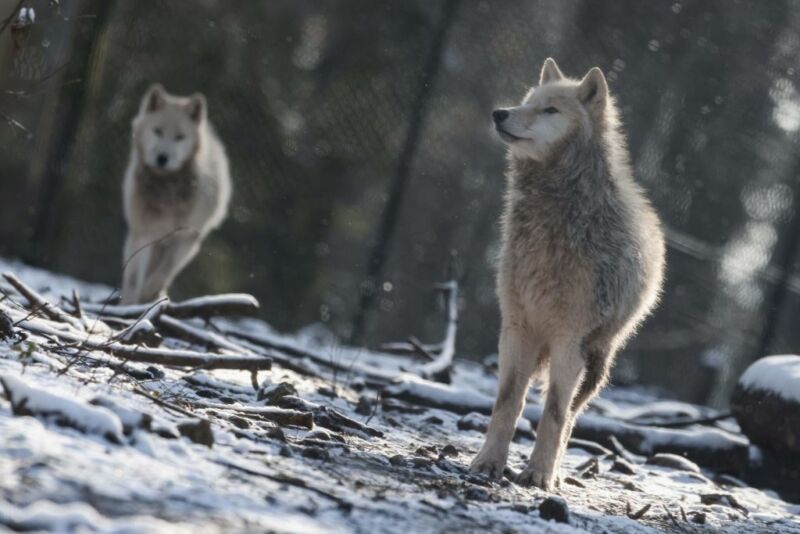Unlucky ungulates —
Wolves scare deer away from highways, a marked economic and ecological benefit.
Doug Johnson
–

Deer don’t seem to understand that large, fast-moving vehicles can lead to their untimely demise. According to the Insurance Information Institute, there were 1.9 million animal (not just deer) collision claims in the US between July 2019 and the end of June 2020.
The ungulates seem to be capable of recognizing other threats, though. Deer understand that they should steer clear of wolves. And new research suggests that regions with wolves tend to have a markedly lower rate of deer-automobile collisions, as the predators scare their prey away from roadways. According to the study’s researchers, this indirect benefit of managing wolves in a region can save humans a lot of money.
The research, which focuses on counties in the Great Lakes region, began in 2013. Grey wolves were delisted from the Endangered Species Act in the Great Lakes region in 2012 as their population grew, but this reprieve was short-lived, as hunting caused the species to be re-listed in the area only around a year later.
“They’ve been delisted and re-listed several times just in the Great Lakes region, and many other times in other parts of the country,” Jennifer Raynor, a natural resource economist at Wesleyan University, told Ars.
As such, Raynor and her team began to measure the indirect benefits of wolves recolonizing different parts of the region. As of this year, wolves have been delisted in every state except Hawaii and Alaska, so the paper can help policymakers make better wolf-management decisions and quantify the “nebulous and tricky” benefits of wolves, she said.
“I was interested to think about how the benefits of predators can be very complicated and difficult to identify, while the costs are quite salient and easy to measure,” Raynor added.
Hungry like the wolves
The team looked at historic deer-collision data in 63 counties—29 of which had wolves—between 1988 and 2016. The researchers matched this data with maps from the Department of Natural Resources showing the times and places where wolves made a comeback. From this, they could glean information about the impact wolves had on deer-automobile collisions, Dominic Parker, an economist at the University of Wisconsin, Madison, told Ars.
“Economists work pretty hard to try to measure the costs and benefits of different things, including the costs and benefits of wildlife species, endangered species, and big predators,” he said. “We think this is a promising way to try to estimate some of those benefits, which can often be difficult to get at.”
In all, the researchers found a 24 percent reduction in deer-automobile collisions as a result of wolf colonization. Three-quarters of this benefit comes from wolves creating what the paper calls a “landscape of fear” and scaring the deer away from roads. The remaining quarter is due to wolves eating enough deer to lower their numbers. The team based its calculations on deer population data in the counties.
Of course, wolves have a negative economic impact, as well—they kill livestock, for instance. But regions with the predators largely came out ahead. The paper notes that there’s an $11 million benefit from collision reductions. According to Parker, this sum is 63 times the cost of the wolves killing livestock.
According to Raynor, ungulates like elk and deer will change their behavior to avoid being eaten when predators are around. Further, wolves often use roads as corridors to move around these regions quickly. As such, the deer tend to steer clear of the areas and thus avoid death by automobile.
This research can be valuable for places with high deer-vehicle collisions and ideal wolf habitats. New England, for example, has a high rate of vehicles killing the overabundant deer in the area. It also has large swathes of forest, ideal stomping grounds for wolves. Raynor noted that wolves might add some other indirect benefits as well. Through predation, wolves may reduce the damage the deer do to crops, for instance. However, Raynor also said that it’s hard to determine if this research could apply to other species.
Unexpected outcomes
Fraser Shilling is the director of the University of California’s Road Ecology Center, an organization that researches the intersection between the environment and transit. He told Ars that there are many instances in which predator decline has had unexpected environmental impacts. For example, wolves were a rare sight in the Greater Yellowstone Ecosystem for much of the previous century.
As the wolves declined, deer and elk populations boomed and heavily grazed the areas near rivers. This change desertified the areas and caused the stream beds to erode. Removing predators from an ecosystem can have unforeseen effects, he noted. “It’s predictable that there will be downstream effects, but it’s not always predictable what they will be,” he said.
Raynor and Parker’s paper also noted that human hunters could not replicate the effects of wolves. While they could indeed kill off many of the deer, their presence did not scare or deter them in the same way as the animals’ natural predators did.
The argument that humans can step in and hunt animals as a form of ecological management is an old one. Shilling noted that there’s a long history of shooting wolves in Alaska—sometimes from the safety of an aircraft—so humans can hunt ungulates for more food. The argument says these hunters can functionally replace the wolves within that ecosystem. While this idea might work in some cases, Raynor and Parker’s research suggests that it’s not always a perfect fix.
“It means that this idea that people can replace the carnivore effect is false, at least in the way they were measuring it,” Shilling said.
PNAS, 2021. DOI: 10.1073/pnas.2023251118

